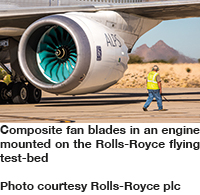Success for workshop on NDT and SHM requirements for aerospace composites
13/05/2016
 On 9-10 February 2016, the Aerospace and Composites Groups of the British Institute of Non-Destructive Testing (BINDT) held a workshop on the non-destructive testing (NDT) and structural health monitoring (SHM) requirements for aerospace composites, which took place at the National Composites Centre (NCC) in Bristol, UK.
On 9-10 February 2016, the Aerospace and Composites Groups of the British Institute of Non-Destructive Testing (BINDT) held a workshop on the non-destructive testing (NDT) and structural health monitoring (SHM) requirements for aerospace composites, which took place at the National Composites Centre (NCC) in Bristol, UK.Over 50 delegates from academia, industry and regulatory bodies attended the two-day workshop, including the main organisers: Professor Robert Smith (BINDT President), Professor Peter Foote, Dr Martin Gaitonde, Dr Barbara Gordon, Professor Phil Irving and Professor Ian Lane.
The aim of the workshop was to establish the requirements of NDT and SHM to facilitate game-changing solutions for new, more efficient composite designs and new design and manufacturing processes for both civil and military aircraft. The idea was to ask the regulation, design, manufacturing, structural integrity and materials communities to inform those in NDT and SHM of the requirements for application, resolution or demonstration. The workshop was host to over 20 presentations plus a series of breakout and panel-led sessions focused on the three main subject areas of adhesive-bonded joints, structural health monitoring and 3D characterisation of wrinkles and porosity. The joined-up approach of the workshop was hugely successful and highly praised by all in attendance.
The outcomes of the workshop were many and varied and included the identification of three generic opportunities where progress in NDT of composites could provide significant benefit for aerospace composites: the design stage; during process verification; and by introducing better-informed concession decisions.
The design stage was confirmed as one of the fundamental areas into which non-destructive evaluation (NDE) needed to be integrated, rather than just the production process, which would increase productivity. Ultimately, moving the benefit of 3D non-destructive characterisation of composites into the design stage as well as the production process could ensure a ‘right first time, every time’ manufacturing process.
It was recognised that work is already underway with regards to the improvement of process verification. Kissing disbond specimens are being produced by collaboration between the NCC, National Physical Laboratory (NPL), 3M and the University of Bristol and will be used to test and evaluate current and future NDT methods for kissing disbond detection. The BINDT Aerospace and Composites Groups are monitoring this activity.
Better-informed concession decisions were identified as an easy way to introduce and validate new NDT from a regulatory point of view, provided the new path is run in parallel with the current airworthiness path. However, for new aircraft, the use of new NDT during the development process is important, rather than leaving it to the certification stage.
The dedication and hard work of the organisers, along with the support of the UK Engineering and Physical Sciences Research Council (EPSRC), the NCC and BINDT, not only made this workshop possible but also strengthened its direction.
“This workshop successfully brought together people from communities who had rarely interacted to define requirements for NDT and SHM. The outcome of this workshop was a detailed definition of what we, as an NDT community, should be aiming for. This was captured in a summary document to be published by BINDT. There will also be a future workshop, in about two years’ time, to track progress,” said Robert Smith.
“This was in just one industry sector, for one type of component; it makes me wonder how many other industry sectors would benefit from an NDT requirements workshop like this. Perhaps this should just be the first of several similar BINDT requirements workshops,” Robert Smith concluded.
For further information, to view the full programme from the workshop or to download the presentations, visit the BINDT website at: www.bindt.org/events/Aerospace-Workshop-February-2016